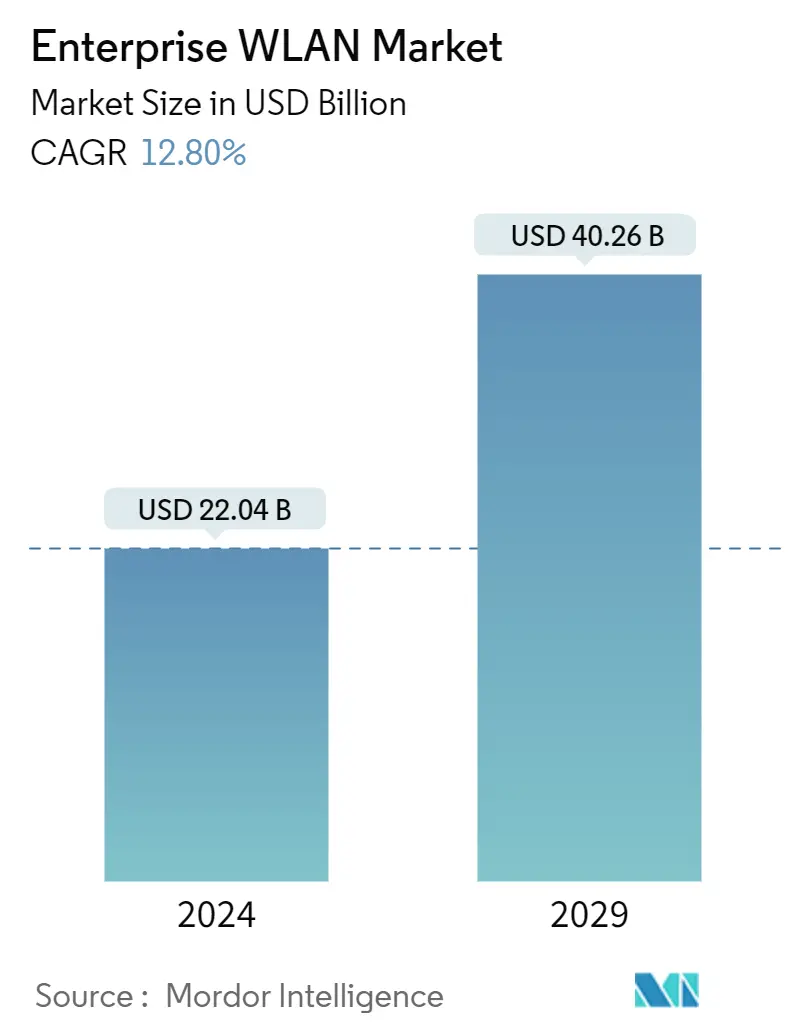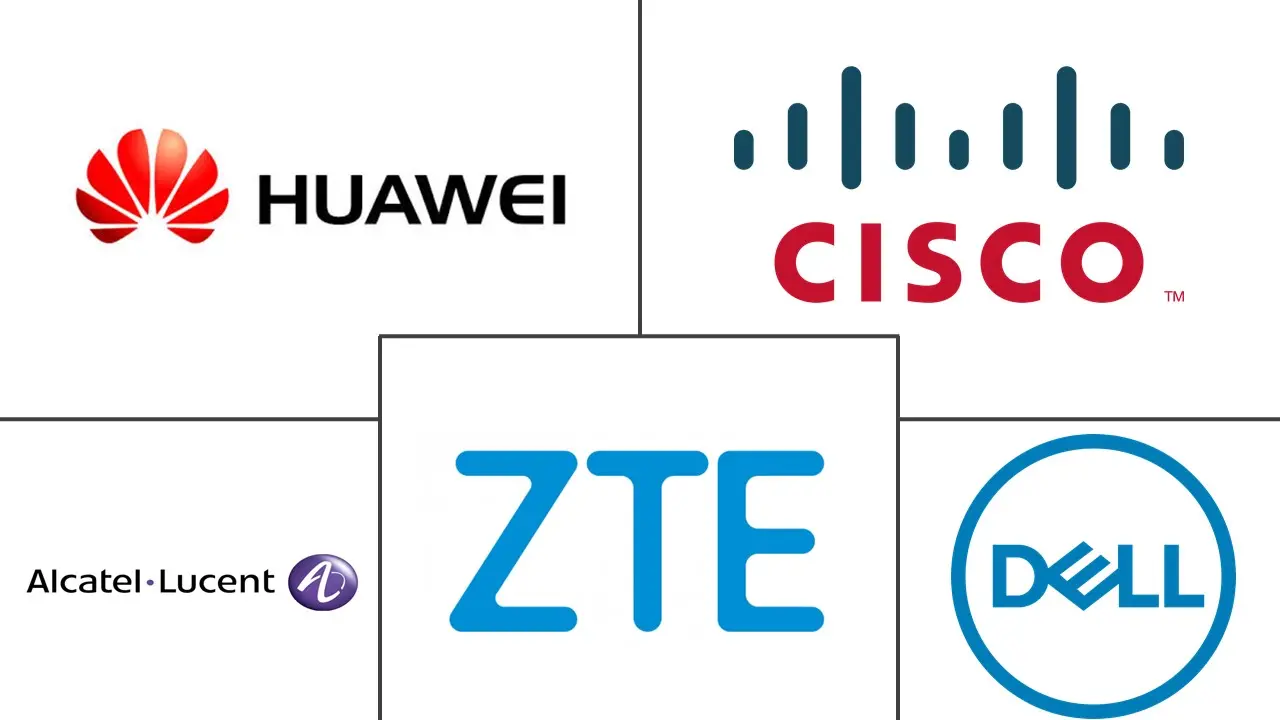Market Size of Enterprise WLAN Industry

| Study Period | 2019-2029 |
| Market Size (2024) | USD 22.04 Billion |
| Market Size (2029) | USD 40.26 Billion |
| CAGR (2024 - 2029) | 12.80 % |
| Fastest Growing Market | Asia Pacific |
| Largest Market | North America |
Major Players
*Disclaimer: Major Players sorted in no particular order |
Enterprise WLAN Market Analysis
The Enterprise WLAN Market size is estimated at USD 22.04 billion in 2024, and is expected to reach USD 40.26 billion by 2029, growing at a CAGR of 12.80% during the forecast period (2024-2029).
The Enterprise WLAN market continues to grow rapidly, emphasizing the importance of wireless technology in the network and digital transformation goals of organizations across the globe.
- The growth of the Enterprise WLAN market is attributed to the increasing demand for reliable, high-speed, and secure wireless networks that can support the growing number of connected devices in the workplace.
- As many organizations are moving their applications and data to the cloud, the requirement for a robust wireless network that can handle the increased traffic and bandwidth demands is increased. Also, as the number of devices connected to a wireless network increases, so does the risk of security breaches that can be protected using advanced security features provided by Enterprises' WLAN solutions.
- The continuous growth of network infrastructure, increased demand for high-speed internet, and introduction of new wireless standards named WIFI6, also known as 802.11ax, is expected to impact the market positively. Also, regularly updating standards improves network throughput in terms of maximum speeds and transmission capabilities.
- The high cost associated with the deployment and maintaining Enterprise WLAN for small and medium-sized businesses is challenging for the growth of the Enterprise WLAN market.
- COVID-19 impacted Enterprise WLAN usage and deployment. The pandemic accelerated the adoption of enterprise WLAN solutions that support remote work and provide greater flexibility and scalability. It also highlighted WLAN security and the need for organizations to be able to adapt to changing traffic patterns. However, the pandemic also caused delays and challenges for WLAN deployment projects, which long-term impacted WLAN adoption and usage.
Enterprise WLAN Industry Segmentation
A wireless LAN (WLAN) is a wireless network that links two or more devices using wireless communication to make an area network (LAN) within a limited area like a home, school, computer laboratory, campus, or office block, allowing the user with quicker downloads, outstanding network reliability, making businesses more efficient. It allows users to move around within the region and remain connected to the network. A WLAN can also connect to the broader Internet through a gateway. Enterprise Wireless LANs are mostly based on IEEE 802.11 standards and are sold under the Wi-Fi brand name.
The Enterprise WLAN Market is segmented by Component (hardware, software, services), organization size (large enterprises, small and medium-sized enterprises), end-user (retail, healthcare, banking, financial services, and insurance), and geography (North America, Europe, Asia Pacific, Latin America, Middle East and Africa). The report offers market forecasts and size in value (USD) for all the above segments.
| By Component | ||||||
| ||||||
| ||||||
|
| By Organization Size | |
| Large Enterprises | |
| Small and Medium-Sized Enterprises |
| By End-user Verticals | |
| Banking, Financial Services and Insurance | |
| Healthcare | |
| Retail | |
| IT and Telecommunications | |
| Other End-user Verticals |
| Geography | |
| North America | |
| Europe | |
| Asia Pacific | |
| Latin America | |
| Middle East and Africa |
Enterprise WLAN Market Size Summary
The Enterprise WLAN market is experiencing significant growth, driven by the increasing demand for reliable, high-speed, and secure wireless networks. This demand is fueled by the rising number of connected devices in workplaces and the shift of applications and data to the cloud, necessitating robust networks to handle increased traffic and bandwidth. The introduction of new wireless standards, such as Wi-Fi 6, is positively impacting the market by enhancing network throughput and transmission capabilities. However, the high costs associated with deploying and maintaining Enterprise WLAN solutions pose challenges, particularly for small and medium-sized businesses. The COVID-19 pandemic has further accelerated the adoption of these solutions, highlighting the importance of WLAN security and the need for adaptability to changing traffic patterns, despite causing some delays in deployment projects.
North America is a key region driving the growth of the Enterprise WLAN market, supported by high mobile device adoption and internet penetration rates. The deployment of 5G technology is enhancing network capacity and speed, creating new opportunities for WLAN vendors. The growing reliance on cloud-based applications in the region is increasing the demand for high-speed wireless connectivity. The market is highly competitive, with major players like Cisco, Huawei, and Extreme Networks focusing on expanding their global customer base and introducing innovative products. Recent advancements include the launch of Wi-Fi 7 access points and solutions designed for enterprise-level environments, which are setting new benchmarks in wireless connectivity.
Enterprise WLAN Market Size - Table of Contents
-
1. MARKET INSIGHTS
-
1.1 Market Overview
-
1.2 Industry Value Chain Analysis
-
1.3 Industry Attractiveness - Porter's Five Forces Analysis
-
1.3.1 Bargaining Power of Suppliers
-
1.3.2 Bargaining Power of Consumers
-
1.3.3 Threat of New Entrants
-
1.3.4 Threat of Substitutes
-
1.3.5 Intensity of Competitive Rivalry
-
-
1.4 Assessment of Impact of COVID-19 on the Industry
-
-
2. MARKET SEGMENTATION
-
2.1 By Component
-
2.1.1 By Hardware
-
2.1.1.1 Access points
-
2.1.1.2 WLAN Controllers
-
2.1.1.3 Wireless Hotspot Gateways
-
-
2.1.2 By Software
-
2.1.2.1 WLAN Security
-
2.1.2.2 WLAN Management
-
2.1.2.3 WLAN Analytics
-
2.1.2.4 Other Softwares
-
-
2.1.3 By Services
-
2.1.3.1 Professional Services
-
-
-
2.2 By Organization Size
-
2.2.1 Large Enterprises
-
2.2.2 Small and Medium-Sized Enterprises
-
-
2.3 By End-user Verticals
-
2.3.1 Banking, Financial Services and Insurance
-
2.3.2 Healthcare
-
2.3.3 Retail
-
2.3.4 IT and Telecommunications
-
2.3.5 Other End-user Verticals
-
-
2.4 Geography
-
2.4.1 North America
-
2.4.2 Europe
-
2.4.3 Asia Pacific
-
2.4.4 Latin America
-
2.4.5 Middle East and Africa
-
-
Enterprise WLAN Market Size FAQs
How big is the Enterprise WLAN Market?
The Enterprise WLAN Market size is expected to reach USD 22.04 billion in 2024 and grow at a CAGR of 12.80% to reach USD 40.26 billion by 2029.
What is the current Enterprise WLAN Market size?
In 2024, the Enterprise WLAN Market size is expected to reach USD 22.04 billion.

